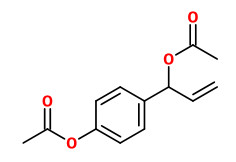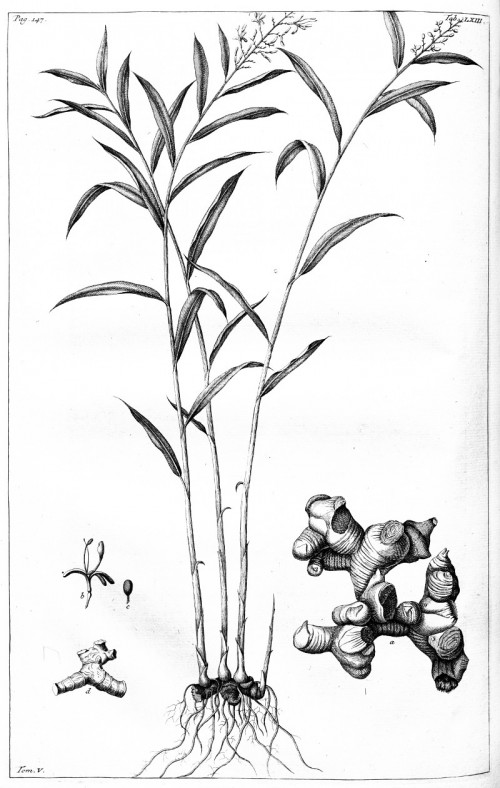Alpinia galanga (L.) Willd. - syn.Languas galanga (L.) Stuntz; Maranta galanga L. - Zingiberaceae
ข่า, Kha (thai), 红豆蔻 hong dou kou (chin.), languas, greater galangal, Thai ginger, Siamese ginger, Thai-Ingwer, Siamesischer Ingwer, Galgant
Perennial herb, up to 2m high, native from South China to Indonesia, cultivated throughout Southeast Asia; rhizomes tuberous; leaves oblong or lanceolate, up to 35cm long; flowers green-white, fragrant; fruits red.
http://www.efloras.org/florataxon.aspx?flora_id=2&taxon_id=200028269
„It is used as an essential part of most spice pastes in Thai cooking“
https://de.wikipedia.org/wiki/Thai-Ingwer
„A. galanga is called laos in Indonesian and is the most common form of galangal used in cooking. It is also known as lengkuas and galanga root… Known as பேரரத்தை (perarathai) in Tamil, this form of ginger is used with licorice root, called in Tamil athi-mathuram (Glycyrrhiza glabra) as folk medicine for colds and sore throats.“
http://en.wikipedia.org/wiki/Alpinia_galanga
„The rhizome is used for indigestion, colic, dysentery and cancer of the stomach. It is a remedy for food poisoning. The grated rhizome is prescribed for spleen trouble and herppes; an infusion of the leaves is for stimulant and antirheumatism. The fresh rhizome is also used as a spice for flavoring food.“
http://list.iupac.org/symposia/proceedings/phuket97/sirirugsa.pdf
„… essential oil was prepared in a low yield (0.04-0.15%,) by steam distillation of fresh, comminuted
rhizomes… Alternatively, the essential oil was isolated by extraction of the steam distillate with dichloromethane. In a third preparation, dried, finely milled rhizomes were submitted to steam distillation and the oil was extracted with dichloromethane (yield 0.4%).“ Main components of the essential oil were 1,8-cineole (58% fresh, 24% dried rhizome) and trans-β-farnesene (8%, 30% resp.). Other monoterpenes were e.g. 4-terpineol (2%/7%) and α-terpineol (2%/0.8%). Methyleugenol, eugenol acetate, chavicol (4-allylphenol) and chavicol acetate were also present together with unidentified substances with woody and incense-like odor. Camphor and methyl cinnamate was not found. There were far more volatile constituents found in fresh than in dried rhizome.
[The essential oil of greater galanga (Alpinia galanga) from Malaysia., De Pooter, H.L., Omar, M.N., Coolsaet, B.A., Schamp, N.M., Phytochemistry, Vol.24(1), 1985, 93-96]
Dried sliced rhizomes of A.galanga contained 1.5% of acetoxychavicol acetate, which was active against seven dermatophytes. MIC values ranged from 50 to 250 microg/ml. The compound was not found in rhizomes of A.officinarum, Zingiber officinale and Kaempferia galanga.
[Acetoxychavicol Acetate, an Antifungal Component of Alpinia galanga L., Janssen, A.M., Scheffer, J.J., Planta medica, Vol.51(6), 1985, 507-511]
 acetoxychavicol acetate (galangal acetate)
acetoxychavicol acetate (galangal acetate)
„Four isomers of acetoxycineoles, (trans and cis)-2- and 3-acetoxy-1,8-cineoles, were identified as the odorous components of the rhizomes of greater galangal. Their structures were confirmed by comparing the retention indices by GC and the mass spectra with those of synthesized compounds. The concentration of trans-3-acetoxy-1,8-cineole was the highest among the isomers. The isomers presented individual odor features: the (trans and cis)-2 isomers respectively exhibited woody and sweet aromas, while the (trans and cis)-3 isomers respectively showed sweet floral and camphoraceous aromas. Of these, trans-2-acetoxy-1,8-cineole seemed to have the strongest qualitative effect on the characteristic flavor of greater galangal.“
[Acetoxy-1,8-cineoles as Aroma Constituents of Alpinia galanga Willd., Kubota, K., Nakamura (Murayam, K., Kobayashi, A., Amaike, M., Journal of agricultural and food chemistry, Vol.46(12), 1998, 5244-5247]
„The pungent principal of galangal [Alpinia galangal (L.) Swartz] rhizomes was isolated and identified as 1‘-acetoxychavicol acetate (galangal acetate). Galangal acetate exhibits a unique pungent sensation, which is less intense than that of capsaicin and without a lingering effect… Galangal acetate is not stable in aqueous solutions and undergoes hydrolysis/isomerization reactions. Therefore, galangal acetate was absent in galangal essential oil obtained by steam distillation. However, galangal acetate was found as one of the major volatile components of the galangal rhizomes by headspace GC analysis. “
[Pungent principal of Alpinia galangal (L.) Swartz and its applications., Yang, X., Eilerman, R.G., Journal of agricultural and food chemistry, Vol.47(4), 1999, 1657-1662]
„The essential oils of the leaves, stems, rhizomes and roots of the medicinal plant Alpinia galanga from southern India were investigated by GC-FID, GC-MS and olfactometry. In all four samples, mono- and sesquiterpenes as well as (E)-methyl cinnamate could be identified. They are responsible for the characteristic odor as well as for the reported use in (folk) medicine and in food products of A. galanga
. The essential oil of A. galanga leaves is rich in 1,8-cineole (28.3%), camphor (15.6%), β-pinene (5.0%), (E)-methyl cinnamate (4.6%), bornyl acetate (4.3%) and guaiol (3.5%). The stem essential oil contains 1,8-cineole (31.1%), camphor (11.0%), (E)-methyl cinnamate (7.4%), guaiol (4.9%), bornyl acetate (3.6%),
β-pinene (3.3%) and α-terpineol (3.3%). 1,8-cineole (28.4%), α-fenchyl acetate (18.4%), camphor (7.7%), (E)-methyl cinnamate (4.2%) and guaiol (3.3%) are the main constituents of the rhizome essential oil. The root essential oil contains α-fenchyl acetate (40.9%), 1,8-cineole (9.4%), borneol (6.3%), bornyl acetate (5.4%) and elemol (3.1%).“
[Analysis of the essential oils of the leaves, stems, rhizomes and roots of the medicinal plant Alpinia galanga from southern India., Jirovetz, L., Buchbauer, G., Shafi, M.P., Leela, N.K., Acta Pharmaceutica -ZAGREB-, Vol.53(2), 2003, 73-82]
http://citeseerx.ist.psu.edu/viewdoc/download?doi=10.1.1.321.7946&rep=rep1&type=pdf
The acetone and ethanolic extracts of A.galanga were active in axenic (aerobic and anaerobic) and intracellular assays to determine the antimycobacterial potential. The aqueous extract did not demonstrate activity under the defined assay parameters. All three extract contained acetoxychavicol acetate.
„A. galanga exhibits anti M.tb activity with multiple modes of action. Since the activity of the extracts was observed under reducing oxygen concentrations, it may be effective in treating the dormant and non-replicating bacteria of latent TB. Though the hypothesis needs further testing, A. galanga being a regular dietary component may be utilized in combination with the conventional TB therapy for enhanced efficacy.“
[ Evaluating the anti Mycobacterium tuberculosis activity of Alpinia galanga (L.) Willd. axenically under reducing oxygen conditions and in intracellular assays., Gupta, P., Bhatter, P., Desiree, D., Tolani, M., Daswani, P., Tetali, P., Birdi, T., BMC complementary and alternative medicine, Vol.14(1), 2014, 84]

Alpinia galanga (L.) Willd. as Galanga major
Rumphius, G.E., Herbarium amboinense, vol.5, p.143, t.63 (1747)
http://plantgenera.org/species.php?id_species=45883
